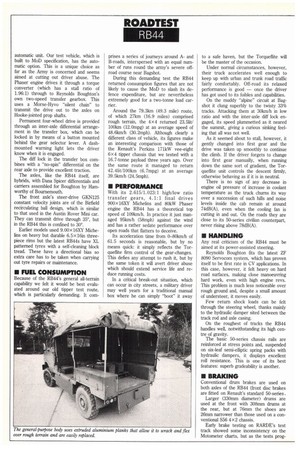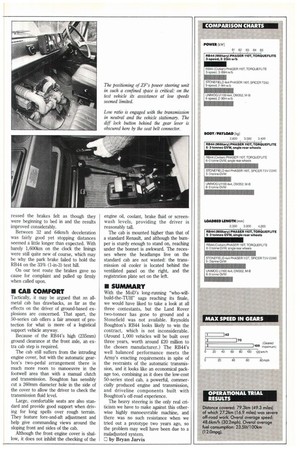ROADTEST RB44
Page 48

Page 49

If you've noticed an error in this article please click here to report it so we can fix it.
automatic unit. Our test vehicle, which is built to MoD specification, has the automatic option. This is a unique choice as far as the Army is concerned and seems aimed at cutting out driver abuse. The Phaser engine drives it through a torque converter (which has a stall ratio of 1.96:1) through to Reynolds Boughton's own two-speed transfer gearbox. This uses a Morse-Hyvo "silent chain" to transmit the drive out to the axles on Hooke-jointed prop shafts.
Permanent four-wheel drive is provided through an inter-axle differential arrangement in the transfer box, which can be locked in by means of a button mounted behind the gear selector lever. A dashmounted warning light lets the driver know when it is engaged.
The diff lock in the transfer box combines with a "no-spin" differential on the rear axle to provide excellent traction.
The axles, like the RB44 itself, are hybrids, with Dana Spicer differentials and carriers assembled for Boughton by Hamworthy of Bournemouth.
The front axle's steer-drive GKN125 constant velocity joints are of the Birfield recirculating ball design, which is similar to that used in the Austin Rover Mini car. They can transmit drive through 35°, but in the RB44 this is confined to 30°.
Earlier models used 9.00 x 16XY Michelins on heavy but durable 6.5x16in threepiece rims but the latest RB44s have XL patterned tyres with a self-cleaning block tread. These have a directional bias so extra care has to be taken when carrying out tyre repairs or maintenance.
• FUEL CONSUMPTION
Because of the RB44's general all-terrain capability we felt it would be best evaluated around our old tipper test route, which is particularly demanding. It corn prises a series of journeys around Aand B-roads, interspersed with an equal number of runs round the army's severe offroad course near Bagshot.
During this demanding test the RB44 returned consumption figures that are not likely to cause the MoD to slash its defence expenditure, but are nevertheless extremely good for a two-tonne load carrier.
Around the 79.31an (49.3 mile) route, of which 27km (16.9 miles) comprised rough terrain, the 4 x4 returned 23.51it/ 100km (12.0mpg) at an average speed of 48.6km/h (30.2mph). Although clearly a different class of vehicle, its figures make an interesting comparison with those of the Renault's Perkins 171kW vee-eight 6x 4 tipper chassis that we tested with a 16.7-tonne payload three years ago. Over the same route it managed to return 42.41it/100km (6.7mpg) at an average 39.5km/h (24.5mph).
• PERFORMANCE
With its 2.615/1.023:1 high/low ratio transfer gears, 4.1:1 final drives 900x 16XY Michelins and 80kW Phaser engine the RB44 has a theoretical top speed of 109km/h. In practice it just managed 95km/h (58mph) against the wind and has a rather sedate performance over open roads that flatters to deceive.
Its acceleration time from 0-80km/h of 61.5 seconds is reasonable, but by no means quick: it simply reflects the Torqueflite firrn control of the gear-changes. This defies any attempt to rush it, but by the same token it will avert driver abuse which should extend service life and reduce running costs.
In a critical break-out situation, which can occur in city streets, a military driver may well yearn for a traditional manual box where he can simply "boot" it away to a safe haven, but the Torquefiite will be the master of the occasion.
Under normal circumstances, however, their truck accelerates well enough to keep up with urban and trunk road traffic fairly comfortably. Off-road its relaxed performance is good — once the driver has got used to its foibles and capabilities.
On the muddy "alpine" circuit at Bagshot it clung superbly to the twisty 33% tracks. Attacking them at 301an/h in low ratio and with the inter-axle diff lock engaged, its speed plununetted as it neared the summit, giving a curious sinking feeling that all was not well.
As it seemed about to stall, however, it gently changed into first gear and the drive was taken up smoothly to continue the climb. If the driver forgets to change into first gear manually, when running down the same sort of gradient, the Torqueflite unit controls the descent firmly, otherwise behaving as if it is in neutral.
There is no sign of any decrease in engine oil pressure of increase in coolant temperature as the truck churns its way over a succession of such hills and noise levels inside the cab remain at around 74dB(A), even when the cooling fan is cutting in and out. On the roads they are close to its 50-series civilian counterpart, never rising above 78dB(A).
• HANDLING
Any real criticism of the RB44 must be aimed at its power-assisted steering.
Reynolds Boughton fits the latest ZF 8090 Servocom system, which has proven itself to be first rate in CV applications. In this case, however, it felt heavy on hard road surfaces, making close manoeuvring hard work, even with high engine revs. This problem is much less noticeable over rough ground and, despite a small amount of understeer, it moves easily.
Few return shock loads can be felt through the steering wheel, thanks mainly to the hydraulic damper sited between the track rod and axle casing.
On the roughest of tracks the R1344 handles well, notwithstanding its high centre of gravity.
The basic 50-series chassis rails are reinforced at stress points and, suspended on six-leaf semi-elliptic spring packs with hydraulic dampers, it displays excellent roll resistance. This is one of its best features: superb gradeability is another.
• BRAKING
Conventional drum brakes are used on both axles of the RB44 (front disc brakes are fitted on Renault's standard 50-series.
Larger (330nun diameter) drums are used at the front with 308mm drums at the rear, but at 76mm the shoes are 26mm narrower than those used on a conventional S56 4 x2 chassis.
Early brake testing on RARDE's test track showed some inconsistency on the Motometer charts, but as the tests prog ressed the brakes felt as though they were beginning to bed in and the results improved considerably.
Between 32 and 641an/h deceleration was fairly good yet stopping distances seemed a little longer than expected. With barely 1,600km on the clock the linings were still quite new of course, which may be why the park brake failed to hold the RB44 on the 33% (1-in-3) test hill.
On our test route the brakes gave no cause for complaint and pulled up firmly when called upon.
• CAB COMFORT
Tactically, it may be argued that an allmetal cab has drawbacks, as far as the effects on the driver of ground-based explosions are concerned. That apart, the 50-series cab offers a fair amount of protection for what is more of a logistical support vehicle anyway.
Because of the RB44's high (235mm) ground clearance at the front axle, an extra cab step is required.
The cab still suffers from the intruding engine cover, but with the automatic gearbox's two-pedal arrangement there is much more room to manoeuvre in the footwell area than with a manual clutch and transmission. Boughton has sensibly cut a 260mm diameter hole in the side of the cover to allow the driver to check the transmission fluid level Large, comfortable seats are also standard and provide good support when driving for long spells over rough terrain. They feature fore-and-aft adjustment and help give commanding views around the sloping front and sides of the cab.
Although the front engine cover is shallow, it does not inhibit the checking of the engine oil, coolant, brake fluid or screenwash levels, providing the driver is reasonably tall.
The cab is mounted higher than that of a standard Renault, and although the bumper is sturdy enough to stand on, reaching under the bonnet is awkward. The recesses where the headlamps live on the standard cab are not wasted: the transmission oil cooler is located behind the ventilated panel on the right, and the registration plate set on the left.
• SUMMARY
With the MoD's long-running "who-willbuild-the-TUH" saga reaching its finale, we would have liked to take a look at all three contestants, but the Land Rover two-tonner has gone to ground and a Stonefield was not available. Reynolds Boughton's RB44 looks likely to win the contract, which is not inconsiderable. (Around 1,000 vehicles will be built over three years, worth around 220 million to the chosen manufacturer.) The RB44's well balanced performance meets the Army's exacting requirements in spite of the restraints of the automatic transmission, and it looks like an economical package too, combining as it does the low-cost 50-series steel cab, a powerful, commercially produced engine and transmission, and driveline components built with Boughton's off-road experience.
The heavy steering is the only real criticism we have to make against this otherwise highly manoeuvrable machine, and there was no such resistance when we tried out a prototype two years ago, so the problem may well have been due to a maladjusted system.
El by Bryan Jarvis


























































































































































